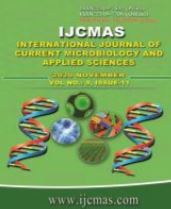


 National Academy of Agricultural Sciences (NAAS)
National Academy of Agricultural Sciences (NAAS)

|
PRINT ISSN : 2319-7692
Online ISSN : 2319-7706 Issues : 12 per year Publisher : Excellent Publishers Email : editorijcmas@gmail.com / submit@ijcmas.com Editor-in-chief: Dr.M.Prakash Index Copernicus ICV 2018: 95.39 NAAS RATING 2020: 5.38 |
A study was conducted to assess the fatty acids composition on post-hatch performance of Japanese quail meat as influenced by supplementing PUFA rich oil sources like fish oil and linseed oil, independently and simultaneously at 2 and 4 per cent levels. The biological experiment was started with a total of five hundred and twenty five day old straight-run Japanese quail chicks up to 5 weeks of age. At the end of five weeks growth study, six birds from each treatment group were drawn randomly and subjected to humane method of slaughter. Breast and thigh meat samples collected and stored during slaughtering process were utilized to study the fatty acid composition of Japanese quail meat. The results revealed that breast and thigh meat obtained from the post-hatch Japanese quail fed with different n-3 PUFA rich oil sources had significantly (P<0.01) lower values of Myristic, Palmitic and Stearic acids when compared to birds received basal diet alone. The statistical analysis showed that the increase in Oleic, Linoleic, Linolenic acids, Eicosapentaenoic acid (EPA), Docosahexaenoic acid (DHA), Total n-3 PUFAs, Total n-6 PUFAs and Total n-3/n-6 fatty acids ratio in breast and thigh meat of post-hatch Japanese quail fed n-3 PUFA rich lipid sources was highly significant (P<0.01). Based on the results of this study, it is concluded that the Japanese quail meat concentrations of Oleic acid, Linoleic acid, Linolenic acid, EPA, DHA, Total n-3 PUFAs, Total n-6 PUFAs and Total n-3 / n-6 fatty acids ratio showed significant (P<0.01) increase with a significant (p<0.01) decrease in Palmitic and Stearic acids content especially in case of Japanese quail fed diets enriched with fish oil and linseed oil at higher levels.
 |
 |
 |
 |
 |